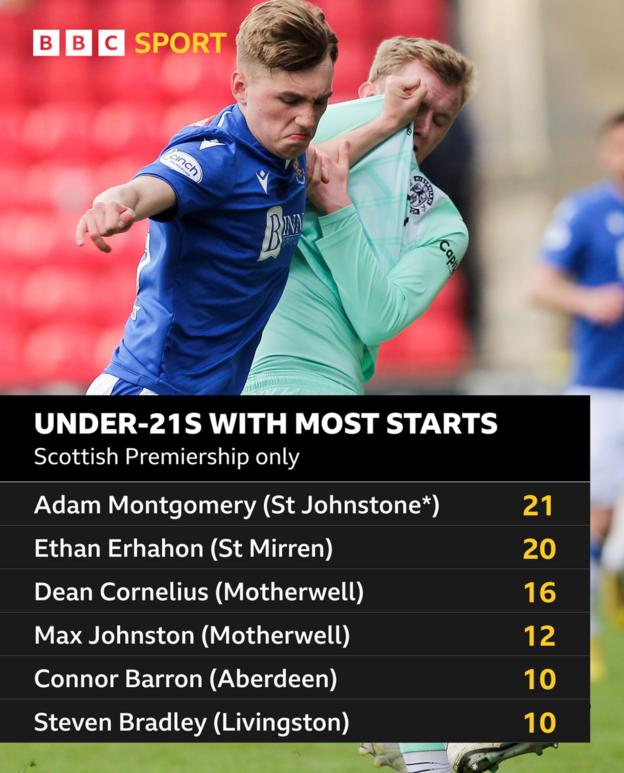
Only 18 Scottish players aged 21 and under when the campaign began have started a match in the Premiership this season.
Of those 18, only eight have started 10 games or more. And if it weren’t for injuries to first-team players, that figure would be even fewer. Two clubs are yet to start a Scottish player aged under 21 in a league match all season.
That fact is stark in a league where clubs need to develop and sell their own to survive, and is worth exploring. Is Scottish football doing enough to develop their own?
Among those eight who have started 10 games or more are Ethan Erhahon, who left St Mirren in January; Max Johnston and Steven Bradley, who only joined their current clubs in the same month; and Connor Barron, who has been injured for large parts of the campaign.
Even if we raise the age bracket to players aged 23 and under, there are still only 37 young Scottish players who have started in the Premiership this season.
According to data compiled by CIES Football Observatory, the average age of a player in the Premiership is 27, which is in the top 10 leagues in Europe for oldest average age.
Only five top flights in the whole continent have a lower percentage of minutes for players who were trained at the club for at least three years between the ages of 15 and 21.
What’s more, similar-sized countries and leagues such as Denmark, Slovakia, Sweden, Norway and Croatia are the top nations when it comes to giving minutes to club-trained players.
What’s clear is young Scottish players are not getting enough game time relative to their counterparts in similar countries. But why?
Pressure on managers & crisis of leadership?
One of the key issues is managers of top-flight clubs are under immense pressure to get results. They get so little time to prove their worth, many turn to older experienced players who, at least on paper, are less likely to make mistakes.
Often that means managers signing players they have worked with before and know well, rather than turning to an unproven academy player.
“There’s a lot of pressure on managers to get instant results and success,” said Livingston manager David Martindale. “That’s going to hamper the development and progression of younger players.”
Many clubs have a commitment to develop their own, but when things get tough it can quickly be forgotten.
Dundee United have committed to a strategy of giving academy players chances in the first team, and last season they gave 16 homegrown players minutes.
Former manager Tam Courts achieved this while leading the club to fourth place and European football. But the next season, with a change of managers, many of those players have been nowhere to be seen.
Andy Goldie was the academy director at United before joining Swansea City last summer.
“I don’t think it correlates exactly, but they’re [United] now near the bottom of the league, and those young players aren’t getting the same opportunity,” he said.
“So what has changed? I do believe it’s that lack of leadership from the very top. They have to make sure the strategy is fed throughout the club to the sporting director and first-team head coach to give young players an opportunity.”

Is a talent drain an issue?
Many clubs will point to the fact their very best youngsters are poached by Premier League and other top European clubs by the time they’ve even reached 18.
Winger Ben Doak went from Celtic to Liverpool at 16, while Rangers striker Rory Wilson opted to join Aston Villa at the same age.
Charlie MacArthur left Kilmarnock for Newcastle at 17, United’s Kerr Smith joined Villa, too, and St Mirren’s Dylan Reid signed for Crystal Palace in January.
Many clubs will have a story like this to tell, with English clubs’ pursuit of young Scottish players intensifying after Brexit made it more difficult to look abroad. It poses a challenge.
“These players would stay if they were playing regular first-team football,” said Goldie.
“Ben Doak has probably played more games for Liverpool, who were Champions League runners-up last season, than the vast majority of Scottish players his age in the Scottish Premiership, which is incredible.”
One of the issues is after under-18 level, players in Scotland have no regular way to play games.
A watered-down reserve league has already been deemed worthless by Celtic, Rangers, Hearts, and Aberdeen, who don’t take part. The former three have B-teams in the Lowland League instead.
Loans can be an effective option for clubs to give players a taste of first-team action and try to bridge the gap. But that doesn’t suit every player, and clubs lose an element of control over the player’s development.
Rangers B-team coach David McCallum was clear about the challenge.
“The gap between academy and first team is too big,” he said. “Reserve-team football is different from what it used to be. You don’t always have the senior players who come down and make it the intense environment you want it to look like.
“We can never replicate what the first-team experience is. The jump is huge.”
Rangers and others believe the B-team model can help narrow the gap, but feel it needs to come with the opportunity to play at a higher level than the Lowland League.
That is hugely controversial in Scotland, because smaller clubs understandably feel it dilutes their existence as a competitive club.
Plans for a new Conference division with B-teams below League 2 seem to have been put into cold storage, so the status quo continues for now.
Colt sides are no panacea in any case, because there still needs to be a pathway from a B-side to the first team no matter what level they are playing at. That requires sustained commitment from clubs.
So what is the future?
Lots of great work goes on in academies across Scottish football. The Scottish FA’s performance school programme – which combines football development with kids’ education – is bearing fruit.
Billy Gilmour, Nathan Patterson and Calvin Ramsay are examples to have come through that programme and made it to the senior Scotland squad, which is at its strongest in 20 years.
Scottish players are thriving in the Premier League and even, remarkably, Italy’s Serie A. There is lots to be positive about.
However, Goldie warns of complacency and describes the Scottish FA’s decision not to replace Malky Mackay directly as performance director in 2020 as “incredible”.
“Scottish football has a real problem with leadership right from the very top,” he adds. “Throughout the association and the clubs as well.”
When Goldie was at Tannadice, the club assessed the average age countries like Croatia and Portugal were giving academy players minutes. They found it was about 17.
Ultimately, Scottish players need to be playing more. And that requires a cultural shift from clubs, governing bodies, and fans.
“The boys need to earn it,” added Goldie. “We don’t see things behind the scenes and how they train compared to other players, I fully appreciate that.
“But if you have a strong, robust, strategy throughout the club then part of that has to be patience and you have to be willing to give young players a run in the team.
“Until clubs do that, players will continue to come down south. Because they can get a far better games programme at under-21s, and a lot of them will get a better opportunity to play first-team football earlier, at a higher level as well.”





